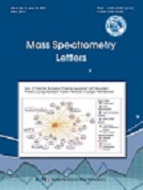
- P-ISSN 2233-4203
- E-ISSN 2093-8950

In the present study, collisionally-activated dissociation (CAD) experiments were performed under low energy collisionconditions in six peptides containing a disulfide bond. Fragments produced as a result of the cleavage of a disulfide bondwere obtained after CAD in four peptides (bactenecin, TGF-α, cortistantin, and linearly linked peptide, Scheme 1) with basicamino acid residues. In contrast, the CAD analysis of two peptides with no basic residue (oxytocin and tocinoic acid) rarely producedfragments indicative of cleavage of a disulfide bond. These results are consistent with the mobile proton model suggestedby the McLuckey and O’Hair groups (ref. 22 and 23); nonmobile protons sequestered at basic amino acid residues appear to promotethe cleavage of disulfide bonds.
Matsumura, M. (1989). . Nature, 342, 2913-.
Loo, J. A. (1990). . Anal. Chem, 62, 693-.
Gunawardena, H. P. (2006). . J. Proteome Res, 5, 2087-.
Stephenson, J. L. Jr. (1999). . Rapid Commun. Mass Spectrom, 13, 2040-.
Gorman, J. J. (2002). . Mass Spectrom. Rev, 21, 183-.
Huwiler, K. G. (2003). . J. Biomol. Technol, 14, 289-.
Fung, E. Y. M. (2005). . Angew. Chem, 117, 6557-.
Chrisman, P. A. (2002). . J. Proteome Res, 1, 549-.
Zhang, Mingxuan. (2006). . Anal. Chem, 78, 4820-.
Bowie, J. H. (2002). . Mass Spectrom. Rev, 21, 87-.
Bilusich, D. (2003). . Rapid Commun. Mass Spectrom, 17, 2488-.
Zubarev, R. A. (1999). . J. Am. Chem. Soc, 121, 2857-.
Ge, Y. (2002). . J. Am. Chem. Soc, 124, 672-.
Syka, J. E. (2004). . Proc. Natl. Acad. Sci. U.S.A, 101, 9528-.
Chrisman, P. A. (2005). . J. Am. Soc. Mass Spectrom, 16, 1020-.
Kalli, A. (2007). . Int. J. Mass Spectrom, 263, 71-.
Lee, M. (2009). . Analyst, 134, 1706-.
Mihalca, R. (2007). . J. Mass Spectrom, 42, 450-.
Lioe, H. (2007). . J. Rapid Commun. Mass Spectrom, 21, 2727-.
Kim, H. I. (2008). . J. Am. Chem. Soc, 130, 1245-.
Jones, M. D. (1998). . Anal. Chem, 70, 136-.
Wells, J. M. (2000). . Int. J. Mass Spectrom, 203, A1-.
Lioe, H. (2007). . J. Am. Soc. Mass Spectrom, 18, 1109-.
Wysocky, V. H. (2000). . J. Mass Spectrom, 35, 1399-.